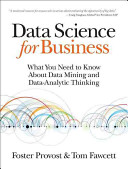

Data-driven decision making is crucial in today's business environment. Organizations that leverage data effectively can gain insights that lead to better strategies and outcomes. The book emphasizes that data science is not just about algorithms and models; it's about using data to inform decisions. This involves understanding the business context, identifying key metrics, and interpreting data to derive actionable insights. The authors highlight that businesses often make decisions based on intuition rather than data, which can lead to suboptimal outcomes. By adopting a data-driven approach, organizations can minimize risks, identify opportunities, and enhance their competitive edge. The book provides examples of companies that have successfully implemented data-driven strategies, illustrating how data can transform business operations and lead to significant improvements in performance.
Continue readingThe data science process is a systematic approach that involves several stages, including problem definition, data collection, data cleaning, exploratory data analysis, modeling, and deployment. The authors emphasize the importance of clearly defining the business problem before diving into data analysis. This ensures that the data science efforts are aligned with business objectives. The book delves into each stage of the process, providing insights into best practices and common pitfalls. For instance, data cleaning is often the most time-consuming part of the process, yet it's critical for ensuring the quality of the analysis. The authors also discuss the significance of exploratory data analysis, which helps to uncover patterns and relationships in the data that can inform modeling decisions. By understanding the data science process, readers can better appreciate the complexities involved and the importance of each stage in deriving meaningful insights.
Continue readingPredictive modeling is a key component of data science that involves using historical data to make predictions about future events. The book covers various predictive modeling techniques, including regression, classification, and clustering. The authors explain how these models can be used to forecast customer behavior, optimize marketing strategies, and improve operational efficiency. They stress the importance of selecting the right model for the specific business problem at hand and highlight the trade-offs involved in different modeling approaches. Additionally, the book addresses the challenges of overfitting and underfitting, which can lead to inaccurate predictions. Through real-world examples, the authors demonstrate how predictive modeling can drive business value, enabling organizations to make informed decisions based on data-driven insights.
Continue readingData visualization is an essential skill for data scientists, as it allows them to effectively communicate their findings to stakeholders. The authors emphasize that data is often complex and difficult to interpret, making visualization a powerful tool for simplifying information and highlighting key insights. The book discusses various visualization techniques and tools, providing guidance on how to choose the right visual for different types of data. The authors also stress the importance of storytelling in data communication, encouraging data scientists to frame their insights in a way that resonates with their audience. By mastering data visualization, readers can enhance their ability to convey complex information clearly and persuasively, ultimately driving better decision-making within their organizations.
Continue readingAs data science becomes increasingly integral to business operations, ethical considerations surrounding data usage are paramount. The book addresses the ethical implications of data collection, analysis, and modeling, highlighting the potential for bias and discrimination in data-driven decisions. The authors advocate for responsible data practices, emphasizing the need for transparency, fairness, and accountability. They encourage data scientists to be aware of the ethical implications of their work and to strive for inclusivity in their analyses. The book also discusses the importance of regulatory compliance and the role of data governance in ensuring ethical data practices. By fostering a culture of ethical responsibility, organizations can build trust with their stakeholders and mitigate the risks associated with data misuse.
Continue readingThe book underscores the importance of collaboration between data scientists and business professionals to achieve successful data science initiatives. The authors argue that data scientists must not only possess technical skills but also understand the business context in which they operate. Similarly, business professionals need to develop a basic understanding of data science concepts to effectively leverage data insights. The book provides strategies for fostering collaboration, such as cross-functional teams and regular communication between data scientists and business stakeholders. By bridging the gap between technical expertise and business acumen, organizations can create a more cohesive approach to data science, leading to more impactful outcomes.
Continue readingThe book concludes with a discussion on the future of data science in business, exploring emerging trends and technologies that are shaping the field. The authors highlight the growing importance of big data, machine learning, and artificial intelligence in driving business innovation. They also discuss the challenges and opportunities presented by these advancements, emphasizing the need for continuous learning and adaptation in the rapidly evolving data landscape. The book encourages readers to stay informed about the latest developments in data science and to embrace a mindset of experimentation and exploration. By doing so, organizations can position themselves to thrive in an increasingly data-driven world.
Continue reading